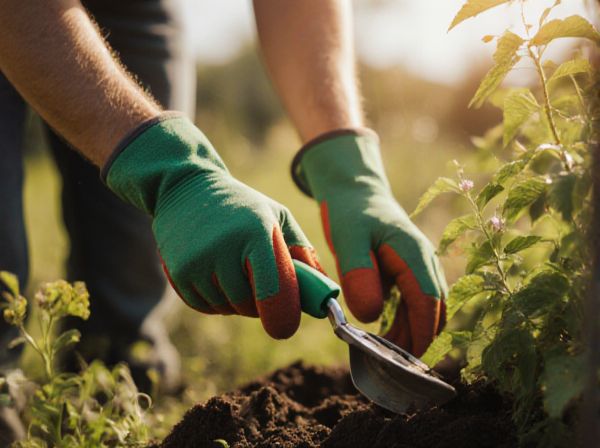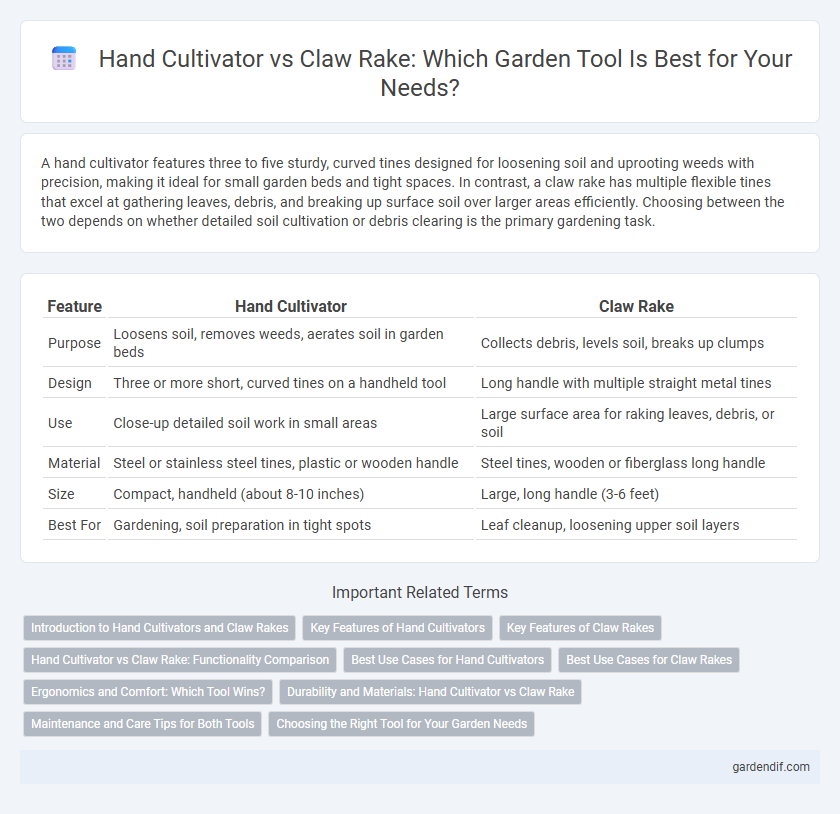
Hand cultivator vs claw rake Illustration
A hand cultivator features three to five sturdy, curved tines designed for loosening soil and uprooting weeds with precision, making it ideal for small garden beds and tight spaces. In contrast, a claw rake has multiple flexible tines that excel at gathering leaves, debris, and breaking up surface soil over larger areas efficiently. Choosing between the two depends on whether detailed soil cultivation or debris clearing is the primary gardening task.
Table of Comparison
| Feature | Hand Cultivator | Claw Rake |
|---|---|---|
| Purpose | Loosens soil, removes weeds, aerates soil in garden beds | Collects debris, levels soil, breaks up clumps |
| Design | Three or more short, curved tines on a handheld tool | Long handle with multiple straight metal tines |
| Use | Close-up detailed soil work in small areas | Large surface area for raking leaves, debris, or soil |
| Material | Steel or stainless steel tines, plastic or wooden handle | Steel tines, wooden or fiberglass long handle |
| Size | Compact, handheld (about 8-10 inches) | Large, long handle (3-6 feet) |
| Best For | Gardening, soil preparation in tight spots | Leaf cleanup, loosening upper soil layers |
Introduction to Hand Cultivators and Claw Rakes
Hand cultivators and claw rakes are essential gardening tools designed for soil preparation and maintenance. Hand cultivators feature multiple tines that penetrate and aerate the soil, ideal for loosening dirt and removing weeds in small garden beds. Claw rakes, with their curved metal tines, effectively gather leaves and debris, while also breaking up hardened soil surfaces for improved garden health.
Key Features of Hand Cultivators
Hand cultivators feature sturdy, curved tines designed for loosening soil in tight garden spaces, promoting aeration and weed removal with precision. Their ergonomic handles enhance grip and reduce hand fatigue, making them ideal for detailed soil preparation around plants. Unlike claw rakes, hand cultivators are compact and versatile, perfect for cultivating small beds and container gardens.
Key Features of Claw Rakes
Claw rakes feature multiple curved tines designed to penetrate and break up soil effectively, making them ideal for loosening compacted earth and removing debris. Their durable steel construction and ergonomic handles provide strength and comfort for extended gardening tasks. Unlike hand cultivators, claw rakes cover larger areas quickly, enhancing efficiency in soil aeration and weed control.
Hand Cultivator vs Claw Rake: Functionality Comparison
A hand cultivator is designed with prongs for breaking up soil and aerating garden beds, making it ideal for detailed soil preparation around plants. In contrast, a claw rake features longer, more widely spaced tines suited for gathering leaves, debris, and loosening surface soil in larger areas. Both tools serve distinct gardening functions, with the hand cultivator focusing on precision cultivation and the claw rake excelling in surface-level cleaning and soil loosening.
Best Use Cases for Hand Cultivators
Hand cultivators excel in aerating soil and removing weeds in small garden beds or tight spaces where precision is essential. They are ideal for loosening soil around plants without damaging roots and mixing in fertilizers or compost to enhance growth. Unlike claw rakes, hand cultivators provide better control for delicate gardening tasks and detailed soil work.
Best Use Cases for Claw Rakes
Claw rakes excel in tasks such as breaking up soil, removing debris, and leveling garden beds, making them ideal for preparing flower beds and vegetable patches. Their sturdy tines efficiently gather rocks, leaves, and weeds, optimizing soil aeration and cleanliness. Unlike hand cultivators, claw rakes cover larger areas quickly, enhancing productivity in medium to large gardening projects.
Ergonomics and Comfort: Which Tool Wins?
Hand cultivators feature ergonomic handles with cushioned grips that reduce hand strain during prolonged use, making them ideal for precision gardening tasks. Claw rakes often have longer handles, promoting better posture and minimizing back discomfort when covering larger garden areas. For ergonomic comfort, hand cultivators excel in detailed work, while claw rakes offer superior support for extended physical use.
Durability and Materials: Hand Cultivator vs Claw Rake
Hand cultivators often feature stainless steel or carbon steel tines paired with hardwood or fiberglass handles, offering high resistance to rust and wear for prolonged garden use. Claw rakes are typically constructed with sturdy steel or aluminum tines combined with hardwood or fiberglass handles, designed to withstand heavy-duty raking and soil movement without bending. The durability of both tools depends on material quality, with hand cultivators excelling in corrosion resistance and claw rakes providing strength for rigorous landscaping tasks.
Maintenance and Care Tips for Both Tools
Hand cultivators require regular cleaning after use to prevent soil buildup and rust, and sharpening the tines periodically maintains their efficiency. Claw rakes benefit from loosening and cleaning debris between the tines after each use, with occasional oiling of the metal parts to avoid corrosion. Storing both tools in a dry place and inspecting wooden handles for cracks can significantly prolong their lifespan and performance.
Choosing the Right Tool for Your Garden Needs
Hand cultivators are ideal for loosening soil and aerating small garden beds, offering precision and control for delicate plants. Claw rakes excel in clearing debris and breaking up compacted soil over larger areas, making them suitable for general garden maintenance. Selecting the right tool depends on your garden size and specific tasks, with hand cultivators favored for detailed work and claw rakes preferred for broader soil management.
Hand cultivator vs claw rake Infographic

 gardendif.com
gardendif.com